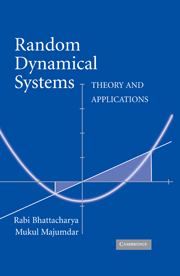Book contents
- Frontmatter
- Contents
- Preface
- Acknowledgment
- Notation
- 1 Dynamical Systems
- 2 Markov Processes
- 3 Random Dynamical Systems
- 4 Random Dynamical Systems: Special Structures
- 5 Invariant Distributions: Estimation and Computation
- 6 Discounted Dynamic Programming Under Uncertainty
- A Appendix
- Bibliography
- Author Index
- Subject Index
3 - Random Dynamical Systems
Published online by Cambridge University Press: 20 February 2010
- Frontmatter
- Contents
- Preface
- Acknowledgment
- Notation
- 1 Dynamical Systems
- 2 Markov Processes
- 3 Random Dynamical Systems
- 4 Random Dynamical Systems: Special Structures
- 5 Invariant Distributions: Estimation and Computation
- 6 Discounted Dynamic Programming Under Uncertainty
- A Appendix
- Bibliography
- Author Index
- Subject Index
Summary
One way which I believe is particularly fruitful and promising is to study what would become of the solution of a deterministic dynamic system if it were exposed to a stream of erratic shocks that constantly upsets the evolution.
Ragnar FrischIntroduction
A random dynamical system is described by a triplet (S, Γ, Q) where S is the state space, Γ an appropriate family of maps from S into itself (interpreted as the set of all admissible laws of motion), and Q is a probability distribution on (some sigmafield of) Γ. The evolution of the system is depicted informally as follows: initially, the system is in some state x in S; an element α1 of Γ is chosen by Tyche according to the distribution Q, and the system moves to the state X1 = α1(x) in period 1. Again, independently of α1, Tyche chooses α2 from Γ according to the same Q, and the state of the system in period 2 is obtained as X2 = α2(X1), and the story is repeated. The initial state x can also be a random variable X0 chosen independently of the maps αn. The sequence Xn so generated is a Markov process. It is an interesting and significant mathematical result that every Markov process on a standard state space may be represented as a random dynamical system. Apart from this formal proposition (see Complements and Details, Proposition C1.1), many important Markov models in applications arise, and are effectively analyzed, as random dynamical systems.
- Type
- Chapter
- Information
- Random Dynamical SystemsTheory and Applications, pp. 245 - 295Publisher: Cambridge University PressPrint publication year: 2007
- 2
- Cited by



